|
It has been almost two months since I reviewed
the new Ruger SP101 chambered
for the .327 Federal Magnum cartridge. The little Ruger
revolver was the first handgun to chamber the new cartridge, and
it is intended and marketed as a defensive cartridge for those
who want deep penetration and expansion, without the recoil and
muzzle blast of the .357 Magnum cartridge. In that role, the
little SP101 performs admirably.
Like many shooters, I have been anxiously
awaiting the arrival of hunting revolvers chambered for the new
cartridge. Freedom Arms in Freedom, Wyoming got on the
project right away, and they are now offering their .32
H&R Magnum Model 97 with an optional .327 Federal
Magnum cylinder, and Freedom will also fit a .327 Federal
cylinder to existing .32 H&R Freedom revolvers.
The Freedom revolver tested here wears a five
and one-half inch barrel, and I was anxious to see what that
extra barrel length and tighter barrel/cylinder gap of just .002
inch would do for velocities, compared to the smaller Ruger with
its three and one-sixteenth inch barrel. The quality of
materials and workmanship on Freedom Arms revolvers is
legendary, so coupled with the longer barrel and target style
rear sight, I also expected better accuracy. The cylinder length
of the Model 97 .327 Federal Magnum measures 1.628, and the
cartridge case heads are recessed into the cylinder, allowing
the use of cartridges loaded to just under the total cylinder
length. The cylinder diameter measures 1.575 inches, and
contains six chambers. The Model 97 weighs 41.4 ounces unloaded,
and has an excellent trigger pull, measuring just two and
three-quarters pounds. This Model 97 wears the exceptional
Freedom Arms fully adjustable rear sight, and has a black ramped
front. The majority of the sixgun is made of stainless steel,
and wears Freedom’s Premier Grade finish, and their perfectly
fitted wood grips.
About two weeks into shooting the new Model 97,
I received a custom Ruger Single Six from Alan
Harton’s Single Action Service, so I decided to review
them both in one article, as they are both intended to be used
as hunting and target shooting guns. The custom Ruger wears a
six and one-half inch barrel, and also has a tight
barrel/cylinder gap of just .003 inch. The standard .32 H&R
Single Six cylinder is too short for the .327 Federal, so a
longer cylinder was fitted, which required slightly shortening
the part of the barrel that protrudes into the cylinder window
of the Single Six. Mr. Harton fitted a new barrel to the frame,
and installed a free-spin pawl that allows the cylinder to
freely spin in either direction when the loading gate is open.
The cylinder length on the custom Ruger is 1.538 inches, and the
case heads are not recessed, allowing for a total overall
cartridge length of 1.581 inches. The cylinder diameter measures
1.462 inches, and the custom Ruger is also chambered to hold six
rounds of .327 Federal Magnum ammunition. The custom Ruger
weighs 38 ounces unloaded. The trigger pull measured a clean,
crisp one pound, fifteen ounces. The Harton custom wears an
excellent adjustable rear sight, and a ramped front. Being a
custom sixgun, barrel lengths, finishes, sights, and grips are
all done to the customer’s specifications.
This review is in no way intended to compare the
Freedom Arms revolver with the Harton custom Ruger. They are
each just two different approaches to achieve the same result.
That is, a high quality hunting and target sixgun chambered for
the .327 Federal Cartridge. The .327 Federal is all that we
hoped that the .32 H&R would be when introduced many years
ago. The pressures on the H&R cartridge were limited by what
the .32 Harrington & Richardson guns could handle.
For years, shooters have been loading the .32 H&R in Ruger
revolvers to true magnum pressures, but with the introduction of
the .327 Federal, the case length is increased, increasing
powder capacity and allowing higher velocities. As far as I
know, there is yet no published pressure tested load data
available, so when loading for the two single action revolvers
reviewed here, I was on my own. Benefiting from my handloading
notes from the review of the SP101, I had a good place to start.
I made a couple of mistakes loading the little Ruger, so I did
not try to push the velocities over safe limits here, but
carefully watch for fired primer condition, ease of extraction,
and measured case head expansion in developing handloads for
these two sixguns. The loads listed here have not been pressure
tested, but proved safe in the two revolvers. If loading the
.327, start with lower powder charges, and pay careful attention
to pressure signs. If extraction gets sticky, back off a bit.
Hopefully, we will soon have good load data from a reliable
source available. The handloads listed here were all loaded on a
Dillon 550B machine using Lee
.32 H&R dies, and all used CCI 550 Magnum Small
Pistol primers. Unless otherwise noted, all bullets were
roll-crimped at their crimp groove or cannelure. The sixty grain
XTP has no cannelure, and was roll-crimped at the start of the
ogive. The loads using the Mt. Baldy
bullets that are noted as “ long” were crimped into the
upper grease groove to increase case capacity. I found no
advantage to seating the bullets long, as I achieved higher
velocities using less powder crimping those bullets in the crimp
groove, but it was worth trying. You can achieve roughly the
same velocities with less pressure by seating them long, but
with the powders chosen here, I prefer to seat the bullets
normally. During velocity testing, the air temperature was
between 42 and 47 degrees Fahrenheit, at an elevation of
approximately 400 feet above sea level. All loads were fired
over the electronic eyes of a PACT Professional
chronograph, and thankfully, it worked well throughout the
velocity tests. I believe that the chronograph was invented
mostly to add aggravation to the lives of gunwriters, but it
does come in handy for load development. Again, the loads listed
below worked well in the two revolvers tested here, but should
be reduced for any other firearm. I started low and worked up
from there. You can too.
I used three jacketed and four cast bullets in
the two revolvers. Many more loads were tested than those shown
here, but these represent the best of the bunch. From my earlier
experience loading the .327 Federal in the SP101, I chose Accurate
Number 9 and Hodgdon H110 as the powders to use in these
two revolvers. In almost every load, the powder charges were
compressed, some heavily. I have had good results with Lil’Gun,
but did not try it with these two revolvers, as I have heard
that Lil’Gun can accelerate forcing cone erosion, and until I
can do further testing to prove or disprove that, I will not use
it in guns that do not belong to me. Also, these two powders
used here will do anything that Lil’Gun will do in the .327
Federal Magnum cartridge. In the table below, XTP is a Hornady
controlled expansion jacketed hollowpoint bullet. The cast lead
bullets are all of LBT or semi-wadcutter shape, and all have
flat nose designs. CP is Cast
Performance Bullet Company. Mt. B is Mt. Baldy Bullet
Company. GC is a gas checked bullet. PB is a plain base cast
lead bullet. K is a cast bullet designed and cast by John
Killebrew, and he was kind enough to run off a batch for me.
He does not sell them. Bullet weights are listed in grains.
Velocity is listed in feet-per-second (fps). In the velocity
listings, FA is Freedom Arms Model 97 with a 5.5 inch barrel,
and SAS is the custom Single Action Service Ruger with a 6.5
inch barrel. I also had all three of the currently produced
factory loads available, and their velocities are included in
the table.
| Bullet |
Powder |
Charge Weight |
Velocity FA |
Velocity SAS |
| 100 XTP |
H110 |
16.5 |
1604.3 |
1707.7 |
| CP 113 GC |
H110 |
16.5 |
1658.8 |
1691 |
| Mt. B 120 GC LONG |
H110 |
16.5 |
1617.1 |
1641.8 |
| Mt. B 120 GC LONG |
AA#9 |
14.3 |
1602.7 |
1613.1 |
| K 135 PB |
H110 |
14.8 |
1579.3 |
1588.6 |
| 85 XTP |
H110 |
17 |
1726.7 |
1742 |
| 60 XTP |
AA#9 |
17.4 |
2142.1 |
2192.7 |
| Mt. B 120 GC |
AA#9 |
13 |
1643.4 |
1649.9 |
| 100 XTP |
AA#9 |
14 |
1692 |
1703.5 |
| CP 113 GC |
AA#9 |
14 |
1617.6 |
1752.4 |
| AE 100 Factory Load |
NA |
NA |
1579.9 |
1649.6 |
| Federal 85 Factory Load |
NA |
NA |
1552.4 |
1611.2 |
| Speer 115 Factory Load |
NA |
NA |
1462.6 |
1578.4 |
In handloading the .327 Federal, pay careful
attention to bullet design. The location of the crimp groove is
important. Depending upon the location of the groove, the powder
capacity is either increased or decreased. Just because a bullet
weighs the same as those listed here, does not mean that powder
charges will be the same.
Accuracy with both revolvers was excellent. I
clamped the Harton Custom Ruger into my Ransom
Master Rest, but had no insert for the Freedom Model 97,
so it was accuracy tested handheld over a solid rest. Both
revolvers proved accurate, but due to different testing methods,
cannot be realistically compared. That really is not important,
however, as both sixguns exhibited superb accuracy with favored
loads. Testing a wide variety of handloads for accuracy, most of
the largest groups fired were in the one and one-half inch range
at twenty-five yards. No group fired exceeded two inches, and
the best loads found for each gun are pictured here. Both
sixguns would group at or under one inch all day long with the
loads that it liked. With the worst loads tested, both revolvers
were still very accurate. I did not have enough factory
ammunition to test those for accuracy. Looking at the velocities
achieved with these two sixguns, I am even more impressed with
the little .327 Federal Magnum than I was when testing the
SP101. I am curious to see what the cartridge can do in even
longer barrels. A seven and one-half inch sixgun would still
carry well in a holster, and I know that Freedom Arms has
produced at least one Model 97 with a ten inch barrel. That gun
will be going to my friend John Taffin for review, so
look for it in either GUNS or AMERICAN HANDGUNNER
magazine soon. Hopefully, someone like Marlin will
produce a handy little carbine chambered for the .327 Federal
magnum cartridge.
For a closer look at the Freedom Arms Model 97,
along with price and options information, go to www.freedomarms.com.
To inquire about having a custom sixgun built by
Alan Harton, give him a call at 713-772-8314 or 713-907-603, or
send an email to aharton@hotmail.com.
For more information on the .327 Federal Magnum
cartridge, go to www.federalcartridge.com.
To order the bullets tested here, go to www.castperformance.com,
www.mtbaldybullets.com,
and www.hornady.com.
Jeff Quinn
|
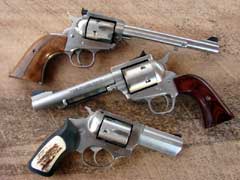
Single Action Service custom Ruger (top);
Freedom Arms Model 97 (center); Ruger SP101 with Sack
Peterson custom American Elk grip inserts (bottom).
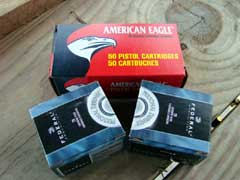

Factory loads tested.


In both sixguns, .312 bullets fit snugly
into the throats.
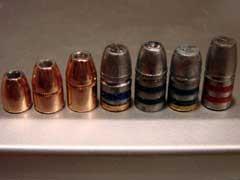
Bullets used in handloads (left to
right): 60-grain Hornady XTP, 85-grain Hornady XTP, 100-grain
Hornady XTP, 113-grain Cast Performance gas-check, 118-grain
Cast Performance plain-base, 120-grain Mt. Baldy gas-check,
135-grain Killibrew plain-base.
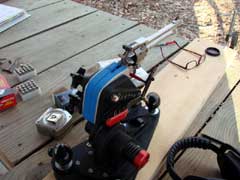
Ransom rest.
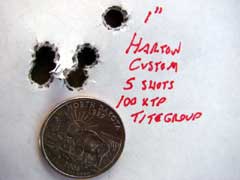
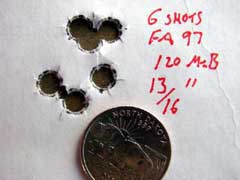
Both sixguns proved to be exceptionally
and consistently accurate.
|
NOTE: All load data posted on this
web site are for educational purposes only. Neither the author nor
GunBlast.com assume any responsibility for the use or misuse of this data.
The data indicated were arrived at using specialized equipment under
conditions not necessarily comparable to those encountered by the
potential user of this data. Always use data from respected loading
manuals and begin working up loads at least 10% below the loads indicated
in the source manual.
  
Got something to say about this article? Want to agree (or
disagree) with it? Click the following link to go to the GUNBlast Feedback Page.
|
|
Click pictures for a larger version.

Single Action Service custom Ruger (top), Freedom Arms
Model 97 (bottom).
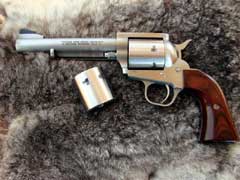

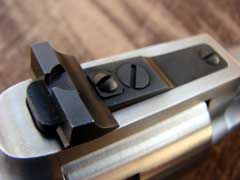
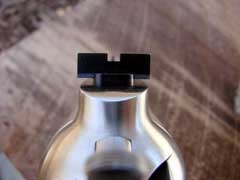

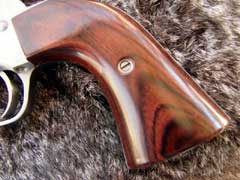
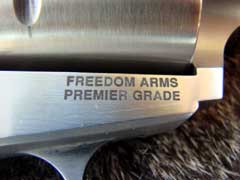
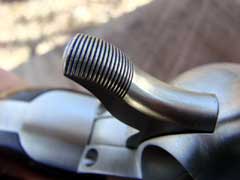
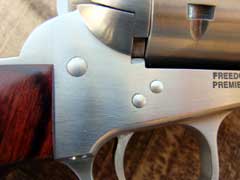

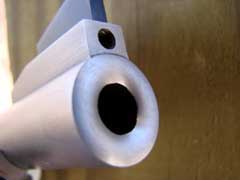
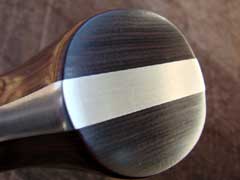
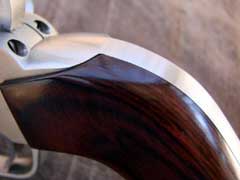
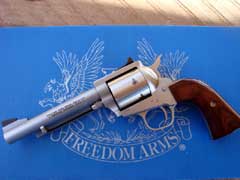
Freedom Arms Model 97.

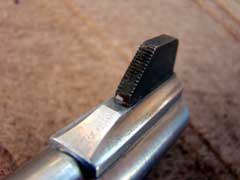
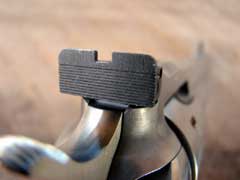
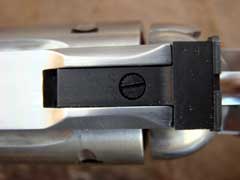
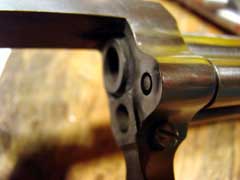
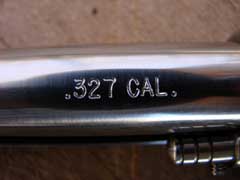
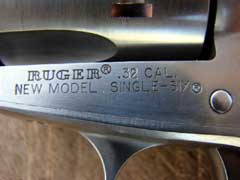
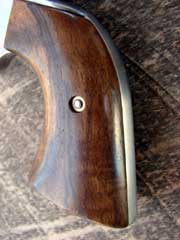
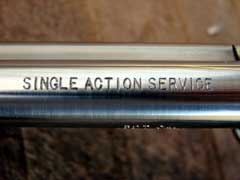
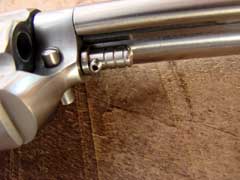
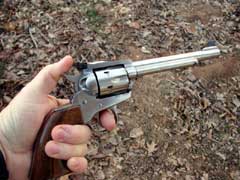
Single Action Service custom Ruger.
|
![]()